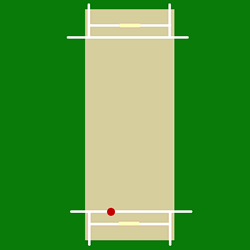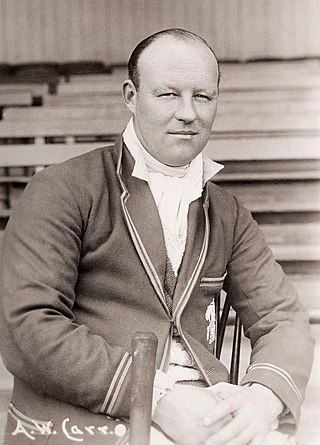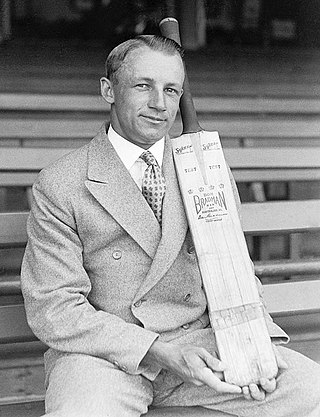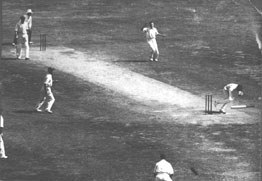Related Research Articles

Bodyline, also known as fast leg theory bowling, was a cricketing tactic devised by the English cricket team for their 1932–33 Ashes tour of Australia. It was designed to combat the extraordinary batting skill of Australia's leading batsman, Don Bradman. A bodyline delivery was one in which the cricket ball was bowled at pace, aimed at the body of the batsman in the expectation that when he defended himself with his bat, a resulting deflection could be caught by one of several fielders deliberately placed nearby on the leg side.

Off spin is a type of finger spin bowling in cricket. A bowler who uses this technique is called an off spinner. Off spinners are right-handed spin bowlers who use their fingers to spin the ball. Their normal delivery is an off break, which spins from left to right when the ball bounces on the pitch. For a right-handed batsman, this is from his off side to the leg side. The ball breaks away from the off side, hence the name 'off break'.

Bowling, in cricket, is the action of propelling the ball toward the wicket defended by a batter. A player skilled at bowling is called a bowler; a bowler who is also a competent batter is known as an all-rounder. Bowling the ball is distinguished from throwing the ball by a strictly specified biomechanical definition, which restricts the angle of extension of the elbow. A single act of bowling the ball towards the batsman is called a ball or a delivery. Bowlers bowl deliveries in sets of six, called an over. Once a bowler has bowled an over, a teammate will bowl an over from the other end of the pitch. The Laws of Cricket govern how a ball must be bowled. If a ball is bowled illegally, an umpire will rule it a no-ball. If a ball is bowled too wide of the striker for the batsman to be able to play at it with a proper cricket shot, the bowler's end umpire will rule it a wide.

Fielding in the sport of cricket is the action of fielders in collecting the ball after it is struck by the striking batter, to limit the number of runs that the striker scores and/or to get a batter out by either catching a hit ball before it bounces, or by running out either batter before they can complete their current run. There are a number of recognised fielding positions and they can be categorised into the offside and leg side of the field. Fielding also involves trying to prevent the ball from making a boundary where four "runs" are awarded for reaching the perimeter and six for crossing it without touching the grass.

Harold Larwood was a professional cricketer for Nottinghamshire County Cricket Club and the England cricket team between 1924 and 1938. A right-arm fast bowler who combined extreme speeds with great accuracy, he was considered by many players and commentators to be the finest and the fastest fast bowler of his generation and one of the fastest bowlers of all time. He was the main exponent of the bowling style known as "bodyline", the use of which during the Marylebone Cricket Club (MCC) tour of Australia in 1932–33 caused a furore that brought about a premature and acrimonious end to his international career.

In cricket, a slip fielder is placed behind the batsman on the off side of the field. They are placed with the aim of catching an edged ball which is beyond the wicket-keeper's reach. Many teams employ two or three slips. A floating slip is sometimes employed, usually in limited over games, who patrols an area in the slip cordon that would ordinarily be occupied by more than one fielder. The slip cordon's distance from the batsman increases with the pace of the bowler; generally they will be marginally further away from the batsman than the wicket-keeper is. Because of the resulting geometry, spin bowlers generally have fewer slips in the cordon than a fast bowler would in an equivalent game situation. As fielding in the slips requires quick reflexes and sure hands, usually the most adept catchers in the team will make up the slip cordon. Most slip fielders are top order batsmen. Specialist slip fielders are sometimes called "slippers".

This is a general glossary of the terminology used in the sport of cricket. Where words in a sentence are also defined elsewhere in this article, they appear in italics. Certain aspects of cricket terminology are explained in more detail in cricket statistics and the naming of fielding positions is explained at fielding (cricket).

Douglas Robert Jardine was an English cricketer who played 22 Test matches for England, captaining the side in 15 of those matches between 1931 and 1934. A right-handed batsman, he is best known for captaining the English team during their successful 1932–33 Ashes tour of Australia. During that series, England employed "Bodyline" tactics against the Australian batsmen, headed by Donald Bradman, wherein bowlers pitched the ball short on the line of leg stump to rise towards the bodies of the batsmen in a manner that some contemporary players and critics viewed as intimidatory and physically dangerous. As captain, Jardine was the person responsible for the implementation of Bodyline.
Off theory is a bowling tactic in the sport of cricket. The term off theory is somewhat archaic and seldom used any more, but the basic tactic still plays a part in modern cricket.

Bill Voce was an English cricketer who played for Nottinghamshire and England. As a fast bowler, he was an instrumental part of England's infamous Bodyline strategy in their tour of Australia in 1932–1933 under Douglas Jardine. He was born at Annesley Woodhouse, near Kirkby-in-Ashfield, Nottinghamshire. He died at Lenton, Nottingham.

Arthur William Carr was an English cricketer. He played for the Nottinghamshire County Cricket Club and the English cricket team, captaining both sides.
Line and length in cricket refers to the direction and point of bouncing on the pitch of a delivery. The two concepts are frequently discussed together.
The English cricket team in Australia in 1946–47 was captained by Wally Hammond, with Norman Yardley as his vice-captain and Bill Edrich as the senior professional. It played as England in the 1946–47 Ashes series against the Australians and as the MCC in their other matches on the tour. They were regarded as a sound team which was just as strong as Australia, but due to the Second World War they were an ageing side and their bowling depended heavily on Alec Bedser and Doug Wright, who were overused and exhausted as a result. Australia beat England 3-0 in a five-match series to retain the Ashes; England suffered the worst defeat in a Test series since losing 4–1 to Australia in 1924–25. Since 1881, Tests in Australia were played to finish. That rule was changed for this series, and for the first time in 65 years, a test played in Australia ended in a draw when the third test was drawn.

A cricket team representing England toured Australia in the 1932–33 season. The tour was organised by the Marylebone Cricket Club and matches outside the Tests were played under the MCC name. The tour included five Test matches in Australia, and England won The Ashes by four games to one. The tour was highly controversial because of the bodyline bowling tactics used by the England team under the captaincy of Douglas Jardine. After the Australian tour was over, the MCC team moved on to play in New Zealand, where two further Test matches were played.

Bodyline is an Australian 1984 television miniseries which dramatised the events of the 1932–1933 English Ashes cricket tour of Australia. The title refers to the bodyline cricketing tactic devised by the English cricket team during their 1932–33 Ashes tour of Australia.

The First Test of the 1948 Ashes series was one of five Tests in The Ashes cricket series between Australia and England. The match was played at Trent Bridge in Nottingham from 10 to 15 June with a rest day on 13 June 1948. Australia won the match by eight wickets to take a 1–0 series lead.

The Third Test of the 1932–33 Ashes series was one of five Tests in a cricket series between Australia and England. The match was played at the Adelaide Oval in Adelaide from 13 to 19 January 1933, with a rest day on 15 January. England won the match by 338 runs to take a series lead of 2 Tests to 1 with 2 Tests to play.

The Adelaide leak was the revelation to the press of a dressing-room incident during the third Test, a cricket match played during the 1932–33 Ashes series between Australia and England, more commonly known as the Bodyline series. During the course of play on 14 January 1933, the Australian Test captain Bill Woodfull was struck over the heart by a ball delivered by Harold Larwood. Although not badly hurt, Woodfull was shaken and dismissed shortly afterwards. On his return to the Australian dressing room, Woodfull was visited by the managers of the Marylebone Cricket Club (MCC) team, Pelham Warner and Richard Palairet. Warner enquired after Woodfull's health, but the latter dismissed his concerns in brusque fashion. He said he did not want to speak to the Englishman owing to the Bodyline tactics England were using, leaving Warner embarrassed and shaken. The matter became public knowledge when someone present leaked the exchange to the press and it was widely reported on 16 January. Such leaks to the press were practically unknown at the time, and the players were horrified that the confrontation became public knowledge.
The 1946–47 Australians defeated the touring England team 3–0 in the 1946–47 Ashes series. First-class cricket had continued in Australia until January 1942 and as grade cricket had continued throughout the war there had been less of an hiatus than in England. Their cricket grounds had not been bombed and compared to austerity Britain, Australia was a land of plenty, which allowed for a more rapid recovery than in the old country, as had happened after the First World War. There was no Sheffield Shield in 1945–46, but the Australian Services XI had played all the states and there had been non-Shield interstate games. However, Australia's main advantage was the encouragement of their younger players, in particular by Bradman. Though overshadowed by the great 1948 Australian team, in 1975 Don Bradman reckoned that it was Australia's strongest post-war home team, with the 1974–75 Australians coming a close second and the 1950–51 Australians third. It was also superior to the pre-war Australian teams, as though they were just as strong in batting they had no fast bowlers and depended heavily on the leg-spin of Clarrie Grimmett and Bill O'Reilly. In 1946–47 Ray Lindwall and Keith Miller emerged as a great new-ball partnership, with quality support from Ernie Toshack, Ian Johnson and Colin McCool. The only area for improvement was in finding another top-order strokemaker, which was soon resolved by the arrival of Neil Harvey.
The England team were unhappy with the umpiring in the 1946–47 Ashes series, in particular when Don Bradman was not given out when caught by Jack Ikin for 28 in the First Test and 22 in the Second. Test cricket was not filmed except for highlights and the notion of Test umpires using slow-motion replays or other modern techniques would have been considered absurd. Instead the umpires had to make judgements based on what they saw in a split-second, and honest mistakes were accepted as part and parcel of the game. However, touring teams sometimes felt that there was a natural bias towards the home team which led to some acrimony if important decisions always went against them. The Australian Ray Robinson wrote in The Cricketer:
Usually debatable decisions work out fairly evenly over a Test rubber, but weight of evidence suggests that the umpires were mistaken in giving Bradman not out caught for 28 in the First Test, Edrich out leg-before-wicket for 89 in the Third Test, and Washbrook out caught behind the wicket for 39 in the Fourth Test. These decisions came at such points in England's bids to gain an advantage that they could almost be termed turning-points of the three games.
References
- ↑ "How the leg-side bouncer blighted gentleman's game". www.dailytelegraph.com.au. 2016-10-11. Retrieved 2020-09-11.
- ↑ "Definition of LEG THEORY". merriam-webster.com. Merriam-Webster . Retrieved 6 March 2012.